Customer Analysis#
Let’s create a helper function.
def customer_top(metric: str, show_cnt: bool=True, ascending=False):
"""Show Top Customers by Metric"""
cols = ['customer_unique_id', metric]
if show_cnt:
cols += ['orders_cnt']
display(
df_customers[cols]
.sort_values(metric, ascending=ascending)
.set_index('customer_unique_id')
.head(10)
)
Number of Customers#
Let’s see the total number of customers.
print(f'Total customers: {df_customers.customer_unique_id.nunique():,}')
Total customers: 95,774
Let’s examine the daily distribution of customers.
pb.configure(
df = df_sales
, time_column = 'order_purchase_dt'
, time_column_label = 'Date'
, metric = 'customer_unique_id'
, metric_label = 'Share of Customers'
, metric_label_for_distribution = 'Number of Customers'
, agg_func = 'nunique'
, norm_by='all'
, axis_sort_order='descending'
)
Let’s see at statistics and distribution of the metric.
pb.metric_info(freq='D')
| Summary | Percentiles | Detailed Stats | Value Counts | |||||||
|---|---|---|---|---|---|---|---|---|---|---|
| Total | 602 (100%) | Max | 1.13k | Mean | 158.57 | 100 | 8 (1%) | |||
| Missing | --- | 99% | 361.98 | Trimmed Mean (10%) | 153.65 | 66 | 7 (1%) | |||
| Distinct | 262 (44%) | 95% | 290.95 | Mode | 100 | 140 | 7 (1%) | |||
| Non-Duplicate | 99 (16%) | 75% | 212.75 | Range | 1128 | 122 | 7 (1%) | |||
| Duplicates | 340 (56%) | 50% | 146 | IQR | 113.50 | 182 | 6 (<1%) | |||
| Dup. Values | 163 (27%) | 25% | 99.25 | Std | 88.15 | 239 | 6 (<1%) | |||
| Zeros | --- | 5% | 45 | MAD | 80.80 | 131 | 6 (<1%) | |||
| Negative | --- | 1% | 10.01 | Kurt | 23.81 | 108 | 6 (<1%) | |||
| Memory Usage | <1 Mb | Min | 4 | Skew | 2.53 | 71 | 6 (<1%) | |||
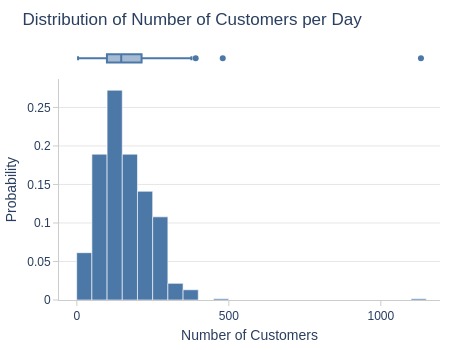
Key Observations:
Typically 100-215 customers made purchases daily
5% of days had ≤45 customers, another 5% had ≥291 customers
Let’s look at the top days by the number of customers.
pb.metric_top(freq='D')
| customer_unique_id | |
|---|---|
| order_purchase_dt | |
| 2017-11-24 | 1132 |
| 2017-11-25 | 480 |
| 2017-11-27 | 391 |
| 2017-11-26 | 377 |
| 2017-11-28 | 369 |
| 2018-08-06 | 368 |
| 2018-05-07 | 362 |
| 2018-08-07 | 360 |
| 2018-05-14 | 355 |
| 2018-05-16 | 350 |
Key Observations:
As expected, Black Friday had the highest daily customer count
Number of Purchases#
Let’s identify the top customers.
customer_top('orders_cnt', show_cnt=False)
| orders_cnt | |
|---|---|
| customer_unique_id | |
| 8d50f5eadf50201ccdcedfb9e2ac8455 | 17 |
| 3e43e6105506432c953e165fb2acf44c | 9 |
| 6469f99c1f9dfae7733b25662e7f1782 | 7 |
| 1b6c7548a2a1f9037c1fd3ddfed95f33 | 7 |
| ca77025e7201e3b30c44b472ff346268 | 7 |
| 63cfc61cee11cbe306bff5857d00bfe4 | 6 |
| dc813062e0fc23409cd255f7f53c7074 | 6 |
| 47c1a3033b8b77b3ab6e109eb4d5fdf3 | 6 |
| f0e310a6839dce9de1638e0fe5ab282a | 6 |
| 12f5d6e1cbf93dafd9dcc19095df0b3d | 6 |
Key Observations:
User ‘8d50f5eadf50201ccdcedfb9e2ac8455’ made the most purchases
Let’s see at statistics and distribution of the metric.
df_customers['orders_cnt'].explore.info(
labels=dict(orders_cnt='Number of Orders per Customer')
, title='Distribution of Number of Orders per Customer'
, xaxis_type='category'
)
| Summary | Percentiles | Detailed Stats | Value Counts | |||||||
|---|---|---|---|---|---|---|---|---|---|---|
| Total | 95.77k (100%) | Max | 17 | Mean | 1.03 | 1 | 92.80k (97%) | |||
| Missing | --- | 99% | 2 | Trimmed Mean (10%) | 1 | 2 | 2.73k (3%) | |||
| Distinct | 9 (<1%) | 95% | 1 | Mode | 1 | 3 | 198 (<1%) | |||
| Non-Duplicate | 2 (<1%) | 75% | 1 | Range | 16 | 4 | 30 (<1%) | |||
| Duplicates | 95.77k (99%) | 50% | 1 | IQR | 0 | 5 | 8 (<1%) | |||
| Dup. Values | 7 (<1%) | 25% | 1 | Std | 0.21 | 6 | 6 (<1%) | |||
| Zeros | --- | 5% | 1 | MAD | 0 | 7 | 3 (<1%) | |||
| Negative | --- | 1% | 1 | Kurt | 426.47 | 9 | 1 (<1%) | |||
| Memory Usage | 1 | Min | 1 | Skew | 11.93 | 17 | 1 (<1%) | |||
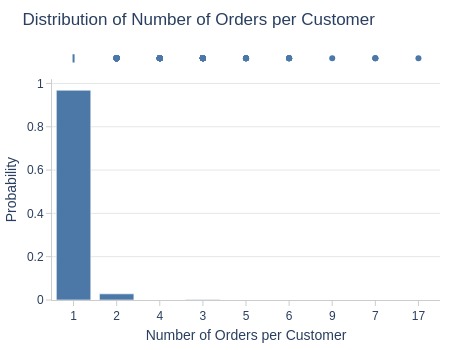
Key Observations:
Most customers (97%) made only 1 purchase ever
Only 3% made >1 successful purchase
Total Purchase Amount#
Let’s identify the top customers.
customer_top('total_customer_payment')
| total_customer_payment | orders_cnt | |
|---|---|---|
| customer_unique_id | ||
| 0a0a92112bd4c708ca5fde585afaa872 | 13,664.08 | 1 |
| da122df9eeddfedc1dc1f5349a1a690c | 7,571.63 | 2 |
| 763c8b1c9c68a0229c42c9fc6f662b93 | 7,274.88 | 1 |
| dc4802a71eae9be1dd28f5d788ceb526 | 6,929.31 | 1 |
| 459bef486812aa25204be022145caa62 | 6,922.21 | 1 |
| ff4159b92c40ebe40454e3e6a7c35ed6 | 6,726.66 | 1 |
| 4007669dec559734d6f53e029e360987 | 6,081.54 | 1 |
| eebb5dda148d3893cdaf5b5ca3040ccb | 4,764.34 | 1 |
| 48e1ac109decbb87765a3eade6854098 | 4,681.78 | 1 |
| c8460e4251689ba205045f3ea17884a1 | 4,655.91 | 4 |
Key Observations:
User ‘0a0a92112bd4c708ca5fde585afaa872’ spent significantly more than others (single purchase)
Let’s see at statistics and distribution of the metric.
df_customers['total_customer_payment'].explore.info(
labels=dict(total_customer_payment='Purchase Amount per Customer')
, title='Distribution of Purchase Amount per Customer'
, upper_quantile=0.99
, hist_mode='dual_hist_trim'
)
| Summary | Percentiles | Detailed Stats | Value Counts | |||||||
|---|---|---|---|---|---|---|---|---|---|---|
| Total | 93.23k (97%) | Max | 13.66k | Mean | 165.17 | 77.57 | 238 (<1%) | |||
| Missing | 2.54k (3%) | 99% | 1.10k | Trimmed Mean (10%) | 123.52 | 35 | 157 (<1%) | |||
| Distinct | 28.21k (29%) | 95% | 469.33 | Mode | 77.57 | 73.34 | 147 (<1%) | |||
| Non-Duplicate | 13.78k (14%) | 75% | 182.46 | Range | 13.65k | 116.94 | 125 (<1%) | |||
| Duplicates | 67.57k (71%) | 50% | 107.78 | IQR | 119.40 | 65 | 107 (<1%) | |||
| Dup. Values | 14.43k (15%) | 25% | 63.06 | Std | 226.42 | 99.90 | 105 (<1%) | |||
| Zeros | --- | 5% | 32.69 | MAD | 79.05 | 107.78 | 105 (<1%) | |||
| Negative | --- | 1% | 22.75 | Kurt | 237.08 | 56.78 | 102 (<1%) | |||
| Memory Usage | 1 | Min | 9.59 | Skew | 9.22 | 67.50 | 98 (<1%) | |||
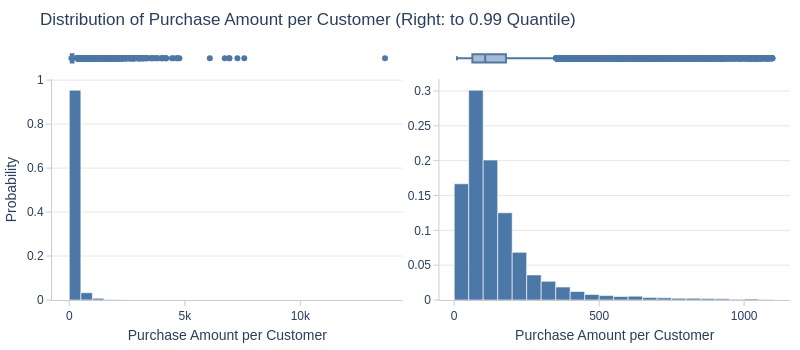
Key Observations:
75% of customers spent <185 R$ lifetime
Top 5% spent ≥470 R$
Average Order Value#
Let’s identify the top customers.
customer_top('avg_total_order_payment')
| avg_total_order_payment | orders_cnt | |
|---|---|---|
| customer_unique_id | ||
| 0a0a92112bd4c708ca5fde585afaa872 | 13,664.08 | 1 |
| 763c8b1c9c68a0229c42c9fc6f662b93 | 7,274.88 | 1 |
| dc4802a71eae9be1dd28f5d788ceb526 | 6,929.31 | 1 |
| 459bef486812aa25204be022145caa62 | 6,922.21 | 1 |
| ff4159b92c40ebe40454e3e6a7c35ed6 | 6,726.66 | 1 |
| 4007669dec559734d6f53e029e360987 | 6,081.54 | 1 |
| eebb5dda148d3893cdaf5b5ca3040ccb | 4,764.34 | 1 |
| 48e1ac109decbb87765a3eade6854098 | 4,681.78 | 1 |
| edde2314c6c30e864a128ac95d6b2112 | 4,513.32 | 1 |
| a229eba70ec1c2abef51f04987deb7a5 | 4,445.50 | 1 |
Key Observations:
User ‘0a0a92112bd4c708ca5fde585afaa872’ has highest average order value (single purchase)
Let’s see at statistics and distribution of the metric.
df_customers['avg_total_order_payment'].explore.info(
labels=dict(avg_total_order_payment='Average Order Value per Customer')
, title='Distribution of Average Order Value per Customer'
, upper_quantile=0.99
, hist_mode='dual_hist_trim'
)
| Summary | Percentiles | Detailed Stats | Value Counts | |||||||
|---|---|---|---|---|---|---|---|---|---|---|
| Total | 93.23k (97%) | Max | 13.66k | Mean | 160.29 | 77.57 | 238 (<1%) | |||
| Missing | 2.54k (3%) | 99% | 1.06k | Trimmed Mean (10%) | 120.21 | 35 | 157 (<1%) | |||
| Distinct | 28.37k (30%) | 95% | 446.43 | Mode | 77.57 | 73.34 | 148 (<1%) | |||
| Non-Duplicate | 14.11k (15%) | 75% | 176.62 | Range | 13.65k | 116.94 | 125 (<1%) | |||
| Duplicates | 67.40k (70%) | 50% | 105.65 | IQR | 114.25 | 65 | 107 (<1%) | |||
| Dup. Values | 14.26k (15%) | 25% | 62.37 | Std | 219.68 | 107.78 | 106 (<1%) | |||
| Zeros | --- | 5% | 32.59 | MAD | 76.44 | 99.90 | 105 (<1%) | |||
| Negative | --- | 1% | 22.69 | Kurt | 251.54 | 56.78 | 104 (<1%) | |||
| Memory Usage | 1 | Min | 9.59 | Skew | 9.42 | 67.50 | 98 (<1%) | |||
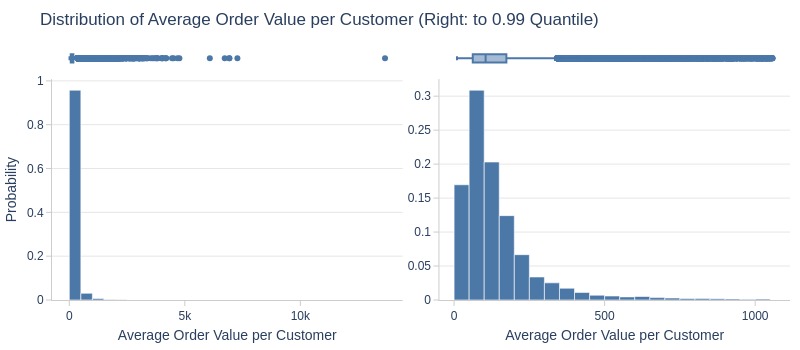
Key Observations:
75% of customers have average order value <180 R$
Top 5% have ≥445 R$
Number of Canceled Orders#
Let’s identify the top customers.
customer_top('canceled_orders_cnt')
| canceled_orders_cnt | orders_cnt | |
|---|---|---|
| customer_unique_id | ||
| 46450c74a0d8c5ca9395da1daac6c120 | 2 | 3 |
| 391d6062da3dd65b4de4524f28c478de | 2 | 2 |
| ff36be26206fffe1eb37afd54c70e18b | 2 | 3 |
| 6ba987d564bad1f9da8e14b9d3b71c8f | 1 | 2 |
| c9d0b6cc7d9fccb750ba1cc6c4b76ecb | 1 | 1 |
| 152e41e668bcc58f2d98dcec34cc5e6f | 1 | 1 |
| 8cfb20eff1ce8185a15ab1df1a8969e3 | 1 | 1 |
| 4fb1141f38a3efb845a83e3da0cf5278 | 1 | 1 |
| f95ccde28c7613a61e9e40681cac6104 | 1 | 1 |
| 8028fbabf6123c13297c82f4393a4724 | 1 | 1 |
Key Observations:
No user canceled >2 orders
Let’s see at statistics and distribution of the metric.
df_customers['canceled_orders_cnt'].explore.info(
labels=dict(canceled_orders_cnt='Number of Canceled Orders')
, title='Distribution of Number of Canceled Orders per Customer'
, xaxis_type='category'
)
| Summary | Percentiles | Detailed Stats | Value Counts | |||||||
|---|---|---|---|---|---|---|---|---|---|---|
| Total | 95.77k (100%) | Max | 2 | Mean | 0.01 | 0 | 95.20k (99%) | |||
| Missing | --- | 99% | 0 | Trimmed Mean (10%) | 0 | 1 | 574 (<1%) | |||
| Distinct | 3 (<1%) | 95% | 0 | Mode | 0 | 2 | 3 (<1%) | |||
| Non-Duplicate | 0 (<1%) | 75% | 0 | Range | 2 | |||||
| Duplicates | 95.77k (99%) | 50% | 0 | IQR | 0 | |||||
| Dup. Values | 3 (<1%) | 25% | 0 | Std | 0.08 | |||||
| Zeros | 95.20k (99%) | 5% | 0 | MAD | 0 | |||||
| Negative | --- | 1% | 0 | Kurt | 168.53 | |||||
| Memory Usage | 1 | Min | 0 | Skew | 12.93 | |||||
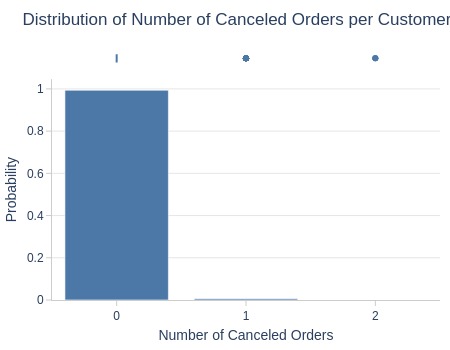
Key Observations:
99% of canceling users only canceled once
Canceled Order Rate#
Let’s see at statistics and distribution of the metric.
df_customers['canceled_share'].explore.info(
labels=dict(canceled_share='Share of Canceled Orders')
, title='Distribution of Share of Canceled Orders per Customer'
, xaxis_type='category'
)
| Summary | Percentiles | Detailed Stats | Value Counts | |||||||
|---|---|---|---|---|---|---|---|---|---|---|
| Total | 95.77k (100%) | Max | 1 | Mean | 0.01 | 0 | 95.20k (99%) | |||
| Missing | --- | 99% | 0 | Trimmed Mean (10%) | 0 | 1 | 504 (<1%) | |||
| Distinct | 5 (<1%) | 95% | 0 | Mode | 0 | 0.50 | 61 (<1%) | |||
| Non-Duplicate | 0 (<1%) | 75% | 0 | Range | 1 | 0.33 | 10 (<1%) | |||
| Duplicates | 95.77k (99%) | 50% | 0 | IQR | 0 | 0.67 | 2 (<1%) | |||
| Dup. Values | 5 (<1%) | 25% | 0 | Std | 0.07 | |||||
| Zeros | 95.20k (99%) | 5% | 0 | MAD | 0 | |||||
| Negative | --- | 1% | 0 | Kurt | 174.22 | |||||
| Memory Usage | 1 | Min | 0 | Skew | 13.22 | |||||
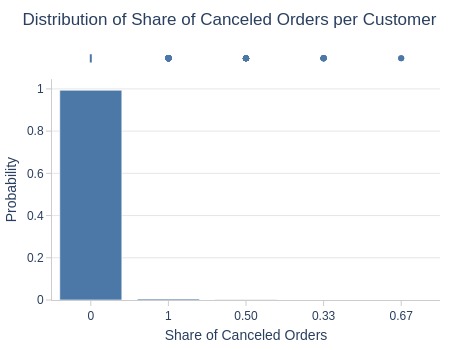
Key Observations:
99% of users never canceled an order
Repeat Purchase Rate#
Let’s identify the top customers.
customer_top('repeat_purchase_share')
| repeat_purchase_share | orders_cnt | |
|---|---|---|
| customer_unique_id | ||
| 8d50f5eadf50201ccdcedfb9e2ac8455 | 0.93 | 17 |
| 3e43e6105506432c953e165fb2acf44c | 0.89 | 9 |
| 1b6c7548a2a1f9037c1fd3ddfed95f33 | 0.86 | 7 |
| ca77025e7201e3b30c44b472ff346268 | 0.86 | 7 |
| 6469f99c1f9dfae7733b25662e7f1782 | 0.86 | 7 |
| 47c1a3033b8b77b3ab6e109eb4d5fdf3 | 0.83 | 6 |
| 12f5d6e1cbf93dafd9dcc19095df0b3d | 0.83 | 6 |
| f0e310a6839dce9de1638e0fe5ab282a | 0.83 | 6 |
| 63cfc61cee11cbe306bff5857d00bfe4 | 0.83 | 6 |
| dc813062e0fc23409cd255f7f53c7074 | 0.83 | 6 |
Key Observations:
User ‘8d50f5eadf50201ccdcedfb9e2ac8455’ has highest repeat purchase rate
Let’s see at statistics and distribution of the metric.
df_customers['repeat_purchase_share'].explore.info(
labels=dict(repeat_purchase_share='Share of Repeat Purchases')
, title='Distribution of Share of Repeat Purchases per Customer'
, nbins=20
, xaxis_type='category'
)
| Summary | Percentiles | Detailed Stats | Value Counts | |||||||
|---|---|---|---|---|---|---|---|---|---|---|
| Total | 93.23k (97%) | Max | 0.93 | Mean | 0.02 | 0 | 90.44k (94%) | |||
| Missing | 2.54k (3%) | 99% | 0.50 | Trimmed Mean (10%) | 0 | 0.50 | 2.56k (3%) | |||
| Distinct | 9 (<1%) | 95% | 0 | Mode | 0 | 0.67 | 179 (<1%) | |||
| Non-Duplicate | 2 (<1%) | 75% | 0 | Range | 0.93 | 0.75 | 29 (<1%) | |||
| Duplicates | 95.76k (99%) | 50% | 0 | IQR | 0 | 0.80 | 9 (<1%) | |||
| Dup. Values | 7 (<1%) | 25% | 0 | Std | 0.09 | 0.83 | 5 (<1%) | |||
| Zeros | 90.44k (94%) | 5% | 0 | MAD | 0 | 0.86 | 3 (<1%) | |||
| Negative | --- | 1% | 0 | Kurt | 30.52 | 0.89 | 1 (<1%) | |||
| Memory Usage | 1 | Min | 0 | Skew | 5.64 | 0.93 | 1 (<1%) | |||

Key Observations:
97% of customers have no repeat purchases
Time Between Purchases#
Let’s identify the top customers.
customer_top('avg_buys_diff_days')
| avg_buys_diff_days | orders_cnt | |
|---|---|---|
| customer_unique_id | ||
| d8f3c4f441a9b59a29f977df16724f38 | 582.86 | 2 |
| a1c61f8566347ec44ea37d22854634a1 | 524.10 | 2 |
| a262442e3ab89611b44877c7aaf77468 | 521.93 | 2 |
| 18bc87094128bbfe943cf88adcf72059 | 514.51 | 2 |
| 7e7301841ddb4064c2f3a31e4c154932 | 514.28 | 2 |
| 24072811917876a84c81166f96aed0c1 | 510.90 | 2 |
| 408aee96c75632a92e5079eee61da399 | 506.27 | 2 |
| 97258e1c1f77f32358eccd1c9ee5954d | 504.65 | 2 |
| 4d9e104764077f7dfae917c7cc803212 | 489.31 | 2 |
| 4658b26bcea972ed0b86a5f8c61718be | 488.84 | 2 |
Key Observations:
Many users show >500 days between purchases, but with very few purchases
Makes average values unreliable
Let’s see at statistics and distribution of the metric.
df_customers['avg_buys_diff_days'].explore.info(
labels=dict(avg_buys_diff_days='Average Time Between Purchases, days')
, title='Distribution of Average Time Between Purchases'
)
| Summary | Percentiles | Detailed Stats | Value Counts | |||||||
|---|---|---|---|---|---|---|---|---|---|---|
| Total | 2.79k (3%) | Max | 582.86 | Mean | 80.05 | 0.00 | 274 (<1%) | |||
| Missing | 92.98k (97%) | 99% | 442.13 | Trimmed Mean (10%) | 58.81 | 0 | 236 (<1%) | |||
| Distinct | 2.15k (2%) | 95% | 311.36 | Mode | 0.00 | 0.00 | 77 (<1%) | |||
| Non-Duplicate | 2.13k (2%) | 75% | 124.55 | Range | 582.86 | 0.00 | 20 (<1%) | |||
| Duplicates | 93.62k (98%) | 50% | 32.60 | IQR | 124.55 | 0.00 | 9 (<1%) | |||
| Dup. Values | 19 (<1%) | 25% | 0.01 | Std | 106.09 | 0.00 | 8 (<1%) | |||
| Zeros | 236 (<1%) | 5% | 0 | MAD | 48.33 | 0.00 | 6 (<1%) | |||
| Negative | --- | 1% | 0 | Kurt | 2.25 | 0.00 | 5 (<1%) | |||
| Memory Usage | 1 | Min | 0 | Skew | 1.63 | 0.00 | 4 (<1%) | |||
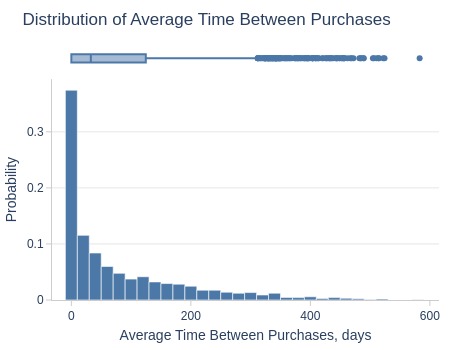
Key Observations:
75% have ≤125 days between purchases
5% have ≥311 days
~30% have <1 day between purchases (likely consecutive orders)
Number of Products per Order#
Let’s identify the top customers.
customer_top('avg_products_cnt')
| avg_products_cnt | orders_cnt | |
|---|---|---|
| customer_unique_id | ||
| 4546caea018ad8c692964e3382debd19 | 21.00 | 1 |
| 698e1cf81d01a3d389d96145f7fa6df8 | 20.00 | 1 |
| c402f431464c72e27330a67f7b94d4fb | 20.00 | 1 |
| 11f97da02237a49c8e783dfda6f50e8e | 15.00 | 1 |
| 31e412b9fb766b6794724ed17a41dfa6 | 14.00 | 1 |
| f7ea4eef770a388bd5b225acfc546604 | 14.00 | 1 |
| 7582a5a77fc2976628f46a13ec91b375 | 13.00 | 1 |
| ce9f8b9c31d83341764708396ac7e38b | 12.00 | 1 |
| d3383e8df3cd44cd351aecff92e34627 | 12.00 | 1 |
| 37bc3d463e2a0024012a7fa587597a3c | 12.00 | 1 |
Key Observations:
Some users average 20-21 items/order (all single orders)
Let’s see at statistics and distribution of the metric.
df_customers['avg_products_cnt'].explore.info(
labels=dict(avg_products_cnt='Average Number of Products in Order')
, title='Distribution of Average Number of Products in Order per Customer'
, width=600
)
| Summary | Percentiles | Detailed Stats | Value Counts | |||||||
|---|---|---|---|---|---|---|---|---|---|---|
| Total | 93.23k (97%) | Max | 21 | Mean | 1.14 | 1 | 83.77k (87%) | |||
| Missing | 2.54k (3%) | 99% | 3 | Trimmed Mean (10%) | 1.00 | 2 | 6.94k (7%) | |||
| Distinct | 39 (<1%) | 95% | 2 | Mode | 1 | 3 | 1.18k (1%) | |||
| Non-Duplicate | 8 (<1%) | 75% | 1 | Range | 20 | 4 | 444 (<1%) | |||
| Duplicates | 95.73k (99%) | 50% | 1 | IQR | 0 | 1.50 | 367 (<1%) | |||
| Dup. Values | 31 (<1%) | 25% | 1 | Std | 0.53 | 5 | 176 (<1%) | |||
| Zeros | --- | 5% | 1 | MAD | 0 | 6 | 168 (<1%) | |||
| Negative | --- | 1% | 1 | Kurt | 121.31 | 2.50 | 36 (<1%) | |||
| Memory Usage | 1 | Min | 1 | Skew | 7.64 | 1.33 | 27 (<1%) | |||
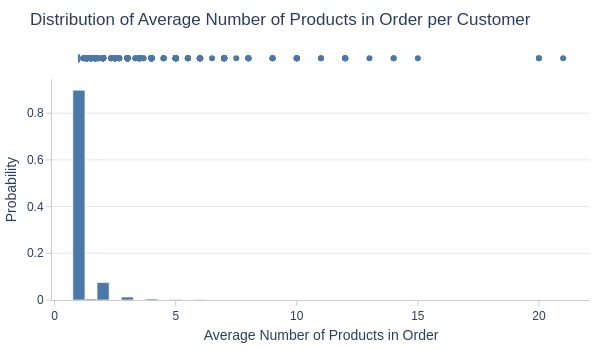
Key Observations:
87% average 1 item/order
~1% average ≥3 items
Product Price per Order#
Let’s identify the top customers.
customer_top('avg_products_price')
| avg_products_price | orders_cnt | |
|---|---|---|
| customer_unique_id | ||
| dc4802a71eae9be1dd28f5d788ceb526 | 6,735.00 | 1 |
| 459bef486812aa25204be022145caa62 | 6,729.00 | 1 |
| ff4159b92c40ebe40454e3e6a7c35ed6 | 6,499.00 | 1 |
| eebb5dda148d3893cdaf5b5ca3040ccb | 4,690.00 | 1 |
| 48e1ac109decbb87765a3eade6854098 | 4,590.00 | 1 |
| edde2314c6c30e864a128ac95d6b2112 | 4,399.87 | 1 |
| fa562ef24d41361e476e748681810e1e | 4,099.99 | 1 |
| ca27f3dac28fb1063faddd424c9d95fa | 4,059.00 | 1 |
| 011875f0176909c5cf0b14a9138bb691 | 3,999.90 | 1 |
| edf81e1f3070b9dac83ec83dacdbb9bc | 3,999.00 | 1 |
Let’s see at statistics and distribution of the metric.
df_customers['avg_products_price'].explore.info(
labels=dict(avg_products_price='Average Product Price in Order')
, title='Distribution of Average Product Price in Order per Customer'
, nbins=20
)
| Summary | Percentiles | Detailed Stats | Value Counts | |||||||
|---|---|---|---|---|---|---|---|---|---|---|
| Total | 93.23k (97%) | Max | 6.74k | Mean | 125.87 | 59.90 | 1.85k (2%) | |||
| Missing | 2.54k (3%) | 99% | 899.99 | Trimmed Mean (10%) | 90.82 | 69.90 | 1.60k (2%) | |||
| Distinct | 7.96k (8%) | 95% | 367.63 | Mode | 59.90 | 49.90 | 1.50k (2%) | |||
| Non-Duplicate | 4.31k (5%) | 75% | 139.90 | Range | 6.73k | 89.90 | 1.22k (1%) | |||
| Duplicates | 87.81k (92%) | 50% | 79 | IQR | 97 | 99.90 | 1.17k (1%) | |||
| Dup. Values | 3.65k (4%) | 25% | 42.90 | Std | 190.66 | 39.90 | 994 (1%) | |||
| Zeros | --- | 5% | 18.90 | MAD | 63.90 | 29.90 | 982 (1%) | |||
| Negative | --- | 1% | 11.49 | Kurt | 117.58 | 79.90 | 981 (1%) | |||
| Memory Usage | 1 | Min | 0.85 | Skew | 7.83 | 19.90 | 941 (<1%) | |||
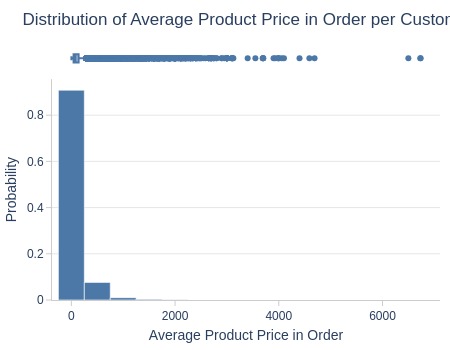
Key Observations:
75% have average product price ≤140 R$
Top 5% have ≥367 R$
Number of Reviews#
Let’s identify the top customers.
customer_top('reviews_cnt')
| reviews_cnt | orders_cnt | |
|---|---|---|
| customer_unique_id | ||
| 8d50f5eadf50201ccdcedfb9e2ac8455 | 15.00 | 17 |
| 3e43e6105506432c953e165fb2acf44c | 9.00 | 9 |
| b4e4f24de1e8725b74e4a1f4975116ed | 7.00 | 5 |
| ca77025e7201e3b30c44b472ff346268 | 7.00 | 7 |
| 47c1a3033b8b77b3ab6e109eb4d5fdf3 | 7.00 | 6 |
| 1b6c7548a2a1f9037c1fd3ddfed95f33 | 7.00 | 7 |
| 6469f99c1f9dfae7733b25662e7f1782 | 7.00 | 7 |
| f0e310a6839dce9de1638e0fe5ab282a | 6.00 | 6 |
| 12f5d6e1cbf93dafd9dcc19095df0b3d | 6.00 | 6 |
| 35ecdf6858edc6427223b64804cf028e | 6.00 | 5 |
Key Observations:
User with id ‘8d50f5eadf50201ccdcedfb9e2ac8455’ left significantly more reviews than other users. But they also made many orders.
Let’s see at statistics and distribution of the metric.
df_customers['reviews_cnt'].explore.info(
labels=dict(reviews_cnt='Number of Reviews per Customer')
, title='Distribution of Number of Reviews per Customer'
, nbins=20
)
| Summary | Percentiles | Detailed Stats | Value Counts | |||||||
|---|---|---|---|---|---|---|---|---|---|---|
| Total | 93.23k (97%) | Max | 15 | Mean | 1.04 | 1 | 90.35k (94%) | |||
| Missing | 2.54k (3%) | 99% | 2 | Trimmed Mean (10%) | 1 | 2 | 2.35k (2%) | |||
| Distinct | 9 (<1%) | 95% | 1 | Mode | 1 | 3 | 369 (<1%) | |||
| Non-Duplicate | 2 (<1%) | 75% | 1 | Range | 14 | 4 | 118 (<1%) | |||
| Duplicates | 95.76k (99%) | 50% | 1 | IQR | 0 | 5 | 23 (<1%) | |||
| Dup. Values | 7 (<1%) | 25% | 1 | Std | 0.25 | 6 | 11 (<1%) | |||
| Zeros | --- | 5% | 1 | MAD | 0 | 7 | 5 (<1%) | |||
| Negative | --- | 1% | 1 | Kurt | 208.46 | 9 | 1 (<1%) | |||
| Memory Usage | 1 | Min | 1 | Skew | 10.27 | 15 | 1 (<1%) | |||

Key Observations:
94% left only 1 review
2% left 2 reviews
Review Score#
Let’s identify the top customers.
customer_top('customer_avg_reviews_score')
| customer_avg_reviews_score | orders_cnt | |
|---|---|---|
| customer_unique_id | ||
| 84732c5050c01db9b23e19ba39899398 | 5.00 | 1 |
| 6c093de8084a2a18102ff996fe31bd93 | 5.00 | 1 |
| 188b92d12c9004c4087ea4d115aba44f | 5.00 | 1 |
| 9387a3940cc2d07a9ec8b85d82fad721 | 5.00 | 1 |
| 32bd15f649096a45270727aa50df8460 | 5.00 | 1 |
| d2cdc1bc229c5e1848f8f7ce60a415f7 | 5.00 | 1 |
| 3277ec319b5ae6c2baff32baeb1c2bf9 | 5.00 | 1 |
| 0e922f6fc526a5e89ae5b96df681a792 | 5.00 | 1 |
| 6a1829a8f4b92d3b96896ef58e522b12 | 5.00 | 1 |
| 25325d558a8e0d36fcd5e3b6a8b80eb6 | 5.00 | 1 |
Let’s see at statistics and distribution of the metric.
df_customers['customer_avg_reviews_score'].explore.info(
labels=dict(customer_avg_reviews_score='Average Review Score per Customer')
, title='Distribution of Average Review Score per Customer'
, nbins=5
)
| Summary | Percentiles | Detailed Stats | Value Counts | |||||||
|---|---|---|---|---|---|---|---|---|---|---|
| Total | 93.23k (97%) | Max | 5 | Mean | 4.14 | 5 | 54.39k (57%) | |||
| Missing | 2.54k (3%) | 99% | 5 | Trimmed Mean (10%) | 4.42 | 4 | 18.22k (19%) | |||
| Distinct | 26 (<1%) | 95% | 5 | Mode | 5 | 1 | 9.29k (10%) | |||
| Non-Duplicate | 6 (<1%) | 75% | 5 | Range | 4 | 3 | 7.78k (8%) | |||
| Duplicates | 95.75k (99%) | 50% | 5 | IQR | 1 | 2 | 2.91k (3%) | |||
| Dup. Values | 20 (<1%) | 25% | 4 | Std | 1.29 | 4.50 | 297 (<1%) | |||
| Zeros | --- | 5% | 1 | MAD | 0 | 3.50 | 156 (<1%) | |||
| Negative | --- | 1% | 1 | Kurt | 0.85 | 2.50 | 79 (<1%) | |||
| Memory Usage | 1 | Min | 1 | Skew | -1.45 | 1.50 | 23 (<1%) | |||
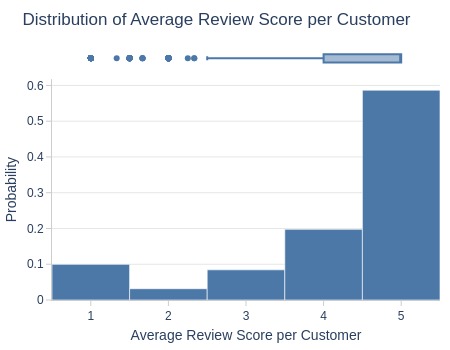
Key Observations:
57% average 5-star reviews
19% average 4-star
Delivery Cost#
Let’s identify the top customers.
customer_top('avg_order_total_freight_value')
| avg_order_total_freight_value | orders_cnt | |
|---|---|---|
| customer_unique_id | ||
| fff5eb4918b2bf4b2da476788d42051c | 1,794.96 | 1 |
| 066ee6b9c6fc284260ff9a1274a82ca7 | 1,002.29 | 1 |
| ef7361e14a64f77990f58e9c571e2f9a | 711.33 | 1 |
| fffcf5a5ff07b0908bd4e2dbc735a684 | 497.42 | 1 |
| 527f7f3237fb1397c459701bc765b6f0 | 497.08 | 1 |
| eae0a83d752b1dd32697e0e7b4221656 | 480.64 | 2 |
| 6d394722d5fc5e721aee6875a218d8db | 479.28 | 1 |
| 6411590d91c48640cb07e72fbb4a359e | 458.73 | 1 |
| f9172a6495d46451776be8bc8e46032d | 456.47 | 1 |
| 3895f60f6e6a89e5cfb7b72ffdcdf7e0 | 436.24 | 1 |
Key Observations:
User ‘fff5eb4918b2bf4b2da476788d42051c’ has unusually high shipping costs (single purchase)
Let’s see at statistics and distribution of the metric.
df_customers['avg_order_total_freight_value'].explore.info(
labels=dict(avg_order_total_freight_value='Average Freight Value ')
, title='Distribution of Average Freight Value per Customer'
, upper_quantile=0.99
, hist_mode='dual_hist_trim'
)
| Summary | Percentiles | Detailed Stats | Value Counts | |||||||
|---|---|---|---|---|---|---|---|---|---|---|
| Total | 93.23k (97%) | Max | 1.79k | Mean | 22.78 | 15.10 | 2.71k (3%) | |||
| Missing | 2.54k (3%) | 99% | 103.50 | Trimmed Mean (10%) | 19.06 | 7.78 | 1.67k (2%) | |||
| Distinct | 8.98k (9%) | 95% | 54.59 | Mode | 15.10 | 14.10 | 1.41k (1%) | |||
| Non-Duplicate | 3.81k (4%) | 75% | 24.10 | Range | 1.79k | 11.85 | 1.33k (1%) | |||
| Duplicates | 86.80k (91%) | 50% | 17.24 | IQR | 10.23 | 18.23 | 1.15k (1%) | |||
| Dup. Values | 5.16k (5%) | 25% | 13.87 | Std | 21.47 | 7.39 | 1.07k (1%) | |||
| Zeros | 330 (<1%) | 5% | 7.89 | MAD | 6.60 | 15.23 | 777 (<1%) | |||
| Negative | --- | 1% | 7.39 | Kurt | 609.04 | 16.11 | 721 (<1%) | |||
| Memory Usage | 1 | Min | 0 | Skew | 12.48 | 8.72 | 685 (<1%) | |||
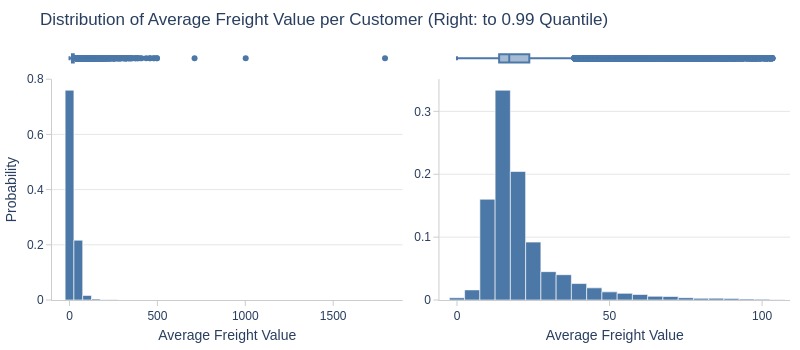
Key Observations:
75% have average shipping ≤24 R$
Top 5% have ≥54 R$
Delivery Time#
Let’s identify the top customers.
customer_top('avg_delivery_time_days')
| avg_delivery_time_days | orders_cnt | |
|---|---|---|
| customer_unique_id | ||
| 4a2519b6991378f6f2ce5ed22d308f03 | 209.63 | 1 |
| eb21169c3153a2b507fc7e76d561ff14 | 208.35 | 1 |
| f0785d41d416fa827f24c4b95d066b69 | 195.63 | 1 |
| c6c0b794d3e4eb69cd85d1438a0db26e | 194.85 | 1 |
| 3c2564d42f7ddd8b7576f0dd9cb1b4c5 | 194.63 | 1 |
| 4df2d7257a7463e2d7a98a5b08cb92fc | 194.05 | 1 |
| 4cb8ad9a4554099db7d70c13d0dae906 | 191.46 | 1 |
| 78d26ae26b5bb9cb398edc7384d3c15f | 189.86 | 1 |
| 186a453a38d349c487ccbf472b31fb39 | 188.13 | 1 |
| e7834c7e017fb854ac65189a66c33132 | 187.74 | 1 |
Let’s see at statistics and distribution of the metric.
df_customers['avg_delivery_time_days'].explore.info(
labels=dict(avg_delivery_time_days='Distribution of Average Delivery Time, days')
, title='Distribution of Average Delivery Time'
, upper_quantile=0.99
, hist_mode='dual_hist_trim'
)
| Summary | Percentiles | Detailed Stats | Value Counts | |||||||
|---|---|---|---|---|---|---|---|---|---|---|
| Total | 93.10k (97%) | Max | 209.63 | Mean | 12.55 | 7.09 | 3 (<1%) | |||
| Missing | 2.67k (3%) | 99% | 45.90 | Trimmed Mean (10%) | 11.15 | 6.20 | 3 (<1%) | |||
| Distinct | 90.70k (95%) | 95% | 29.19 | Mode | Multiple | 9.00 | 3 (<1%) | |||
| Non-Duplicate | 88.34k (92%) | 75% | 15.68 | Range | 209.10 | 6.07 | 3 (<1%) | |||
| Duplicates | 5.07k (5%) | 50% | 10.22 | IQR | 8.90 | 10.07 | 3 (<1%) | |||
| Dup. Values | 2.35k (2%) | 25% | 6.78 | Std | 9.53 | 12.34 | 3 (<1%) | |||
| Zeros | --- | 5% | 3.03 | MAD | 6.13 | 2.07 | 3 (<1%) | |||
| Negative | --- | 1% | 1.83 | Kurt | 40.74 | 13.15 | 3 (<1%) | |||
| Memory Usage | 1 | Min | 0.53 | Skew | 3.91 | 5.88 | 3 (<1%) | |||
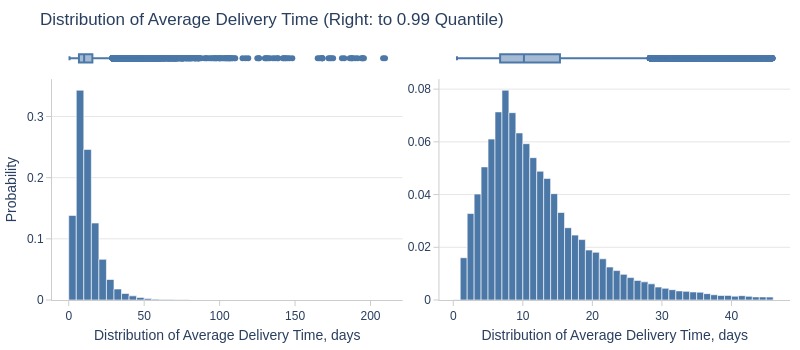
Key Observations:
75% have average delivery ≤16 days
Top 5% have ≥29 days
Delivery Delay Time#
Let’s identify the top customers.
customer_top('avg_delivery_delay_days')
| avg_delivery_delay_days | orders_cnt | |
|---|---|---|
| customer_unique_id | ||
| eb21169c3153a2b507fc7e76d561ff14 | 188.98 | 1 |
| 4a2519b6991378f6f2ce5ed22d308f03 | 181.61 | 1 |
| 4cb8ad9a4554099db7d70c13d0dae906 | 175.87 | 1 |
| 78d26ae26b5bb9cb398edc7384d3c15f | 167.71 | 1 |
| 3c2564d42f7ddd8b7576f0dd9cb1b4c5 | 166.58 | 1 |
| f0785d41d416fa827f24c4b95d066b69 | 165.63 | 1 |
| e7834c7e017fb854ac65189a66c33132 | 162.72 | 1 |
| beba456e33133cc65b481399d051b2ba | 161.78 | 1 |
| 4df2d7257a7463e2d7a98a5b08cb92fc | 161.61 | 1 |
| 186a453a38d349c487ccbf472b31fb39 | 159.61 | 1 |
Let’s see at statistics and distribution of the metric.
df_customers['avg_delivery_delay_days'].explore.info(
labels=dict(avg_delivery_delay_days='Average Delivery Delay Time, days')
, title='Distribution of Average Delivery Delay Time'
, lower_quantile=0.01
, upper_quantile=0.99
, hist_mode='dual_hist_trim'
)
| Summary | Percentiles | Detailed Stats | Value Counts | |||||||
|---|---|---|---|---|---|---|---|---|---|---|
| Total | 93.10k (97%) | Max | 188.98 | Mean | -11.08 | -12.39 | 5 (<1%) | |||
| Missing | 2.67k (3%) | 99% | 18.85 | Trimmed Mean (10%) | -11.44 | -14.44 | 4 (<1%) | |||
| Distinct | 89.02k (93%) | 95% | 3.81 | Mode | -12.39 | -13.26 | 4 (<1%) | |||
| Non-Duplicate | 85.19k (89%) | 75% | -6.38 | Range | 334.99 | -13.28 | 4 (<1%) | |||
| Duplicates | 6.75k (7%) | 50% | -11.61 | IQR | 9.82 | -13.29 | 4 (<1%) | |||
| Dup. Values | 3.83k (4%) | 25% | -16.21 | Std | 10.05 | -8.19 | 4 (<1%) | |||
| Zeros | --- | 5% | -25.29 | MAD | 6.98 | -13.17 | 4 (<1%) | |||
| Negative | 85.56k (89%) | 1% | -34.21 | Kurt | 30.06 | -7.22 | 4 (<1%) | |||
| Memory Usage | 1 | Min | -146.02 | Skew | 2.22 | -7.20 | 4 (<1%) | |||
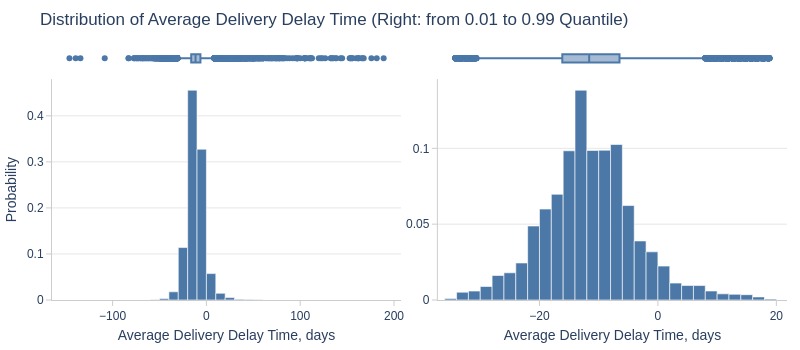
Key Observations:
Top 5% have ≥25 days early delivery
Median: 6-16 days early
Bottom 5% have ≥4 days late
Order Weight#
Let’s identify the top customers.
customer_top('avg_order_total_weight_kg')
| avg_order_total_weight_kg | orders_cnt | |
|---|---|---|
| customer_unique_id | ||
| 3d47f4368ccc8e1bb4c4a12dbda7111b | 184.40 | 1 |
| 066ee6b9c6fc284260ff9a1274a82ca7 | 154.20 | 1 |
| f0d3389b217aa61b5a66744ddd694cc3 | 144.30 | 1 |
| 6d394722d5fc5e721aee6875a218d8db | 129.34 | 1 |
| fff5eb4918b2bf4b2da476788d42051c | 112.20 | 1 |
| 559026a1299bd2ede976c8d516d92258 | 108.50 | 1 |
| 96e91c0dba30f7ff60c9acd47677c248 | 98.40 | 1 |
| 38a4f1deb45ca914dd13c73b41775d71 | 97.00 | 1 |
| fb98136edc2c0f996bfad36a0c7e1306 | 96.80 | 1 |
| 064fb6f70338688d1372235d95d92ff7 | 93.90 | 1 |
Let’s see at statistics and distribution of the metric.
df_customers['avg_order_total_weight_kg'].explore.info(
labels=dict(avg_order_total_weight_kg='Average Order Weight per Customer')
, title='Distribution of Average Order Weight per Customer'
, upper_quantile=0.99
, hist_mode='dual_hist_trim'
)
| Summary | Percentiles | Detailed Stats | Value Counts | |||||||
|---|---|---|---|---|---|---|---|---|---|---|
| Total | 93.23k (97%) | Max | 184.40 | Mean | 2.39 | 0.20 | 5.04k (5%) | |||
| Missing | 2.54k (3%) | 99% | 22.35 | Trimmed Mean (10%) | 1.31 | 0.15 | 3.96k (4%) | |||
| Distinct | 2.15k (2%) | 95% | 10.48 | Mode | 0.20 | 0.25 | 3.51k (4%) | |||
| Non-Duplicate | 846 (<1%) | 75% | 2.10 | Range | 184.40 | 0.30 | 3.49k (4%) | |||
| Duplicates | 93.62k (98%) | 50% | 0.75 | IQR | 1.80 | 0.40 | 3.13k (3%) | |||
| Dup. Values | 1.30k (1%) | 25% | 0.30 | Std | 4.75 | 0.10 | 2.68k (3%) | |||
| Zeros | 5 (<1%) | 5% | 0.15 | MAD | 0.82 | 0.35 | 2.62k (3%) | |||
| Negative | --- | 1% | 0.10 | Kurt | 99.02 | 0.50 | 2.26k (2%) | |||
| Memory Usage | 1 | Min | 0 | Skew | 6.64 | 0.60 | 2.16k (2%) | |||
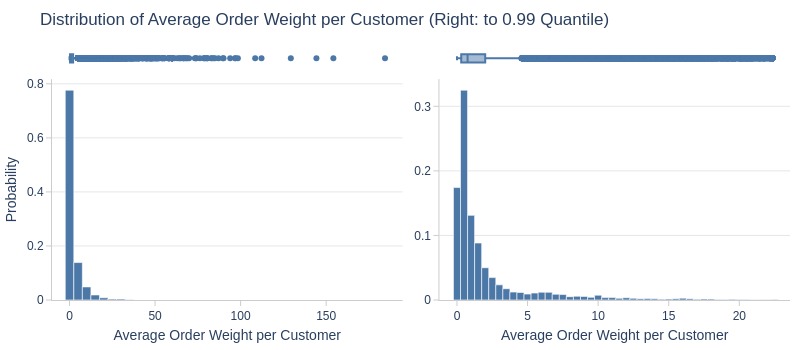
Key Observations:
75% have average order weight ≤2kg
Top 5% have ≥10kg
Time from First to Second Purchase#
Let’s identify the top customers.
customer_top('from_first_to_second_days')
| from_first_to_second_days | orders_cnt | |
|---|---|---|
| customer_unique_id | ||
| d8f3c4f441a9b59a29f977df16724f38 | 582.86 | 2 |
| a1c61f8566347ec44ea37d22854634a1 | 524.10 | 2 |
| a262442e3ab89611b44877c7aaf77468 | 521.93 | 2 |
| 18bc87094128bbfe943cf88adcf72059 | 514.51 | 2 |
| 7e7301841ddb4064c2f3a31e4c154932 | 514.28 | 2 |
| 24072811917876a84c81166f96aed0c1 | 510.90 | 2 |
| 408aee96c75632a92e5079eee61da399 | 506.27 | 2 |
| 97258e1c1f77f32358eccd1c9ee5954d | 504.65 | 2 |
| e53fd5575f1418397aae732c5755b6fc | 490.70 | 3 |
| 4d9e104764077f7dfae917c7cc803212 | 489.31 | 2 |
Key Observations:
User ‘d8f3c4f441a9b59a29f977df16724f38’ has longest 1st→2nd purchase gap
customer_top('from_first_to_second_days', ascending=True)
| from_first_to_second_days | orders_cnt | |
|---|---|---|
| customer_unique_id | ||
| 3a649b3c6b379a427fa6f4a5f646a43d | 0.00 | 2 |
| 0710e0c85fe7cb494d624e0863782e46 | 0.00 | 2 |
| d927267e54f07b9e0fd408d2f840024c | 0.00 | 2 |
| c0118e2c0a037c31aeca71d0b81f66a1 | 0.00 | 3 |
| 271d3cdd872021b1b6669ad93e8b856b | 0.00 | 2 |
| 75a2adfe9f86d401f24b5fe2eb9a582c | 0.00 | 2 |
| 64a5301ff6bdaf1baa00058672402d7a | 0.00 | 2 |
| cfe96f24bd8c36325e0d92e44324cf66 | 0.00 | 2 |
| 897ecc46977d723a6e514f3ebe92c844 | 0.00 | 2 |
| 5c5a99e5ef172fbf5fc8a68e6bb2e0ab | 0.00 | 2 |
Key Observations:
Some customers made 1st/2nd purchases within seconds
Let’s see at statistics and distribution of the metric.
df_customers['from_first_to_second_days'].explore.info(
labels=dict(from_first_to_second_days='Time From First to Second Purchase, days')
, title='Distribution of Time From First to Second Purchase'
)
| Summary | Percentiles | Detailed Stats | Value Counts | |||||||
|---|---|---|---|---|---|---|---|---|---|---|
| Total | 2.79k (3%) | Max | 582.86 | Mean | 80.24 | 0.00 | 296 (<1%) | |||
| Missing | 92.98k (97%) | 99% | 443.75 | Trimmed Mean (10%) | 58.48 | 0 | 253 (<1%) | |||
| Distinct | 2.11k (2%) | 95% | 318.98 | Mode | 0.00 | 0.00 | 82 (<1%) | |||
| Non-Duplicate | 2.09k (2%) | 75% | 125.49 | Range | 582.86 | 0.00 | 23 (<1%) | |||
| Duplicates | 93.66k (98%) | 50% | 28.91 | IQR | 125.49 | 0.00 | 9 (<1%) | |||
| Dup. Values | 18 (<1%) | 25% | 0.00 | Std | 108.08 | 0.00 | 7 (<1%) | |||
| Zeros | 253 (<1%) | 5% | 0 | MAD | 42.87 | 0.00 | 5 (<1%) | |||
| Negative | --- | 1% | 0 | Kurt | 2.07 | 0.00 | 4 (<1%) | |||
| Memory Usage | 1 | Min | 0 | Skew | 1.60 | 0.00 | 3 (<1%) | |||
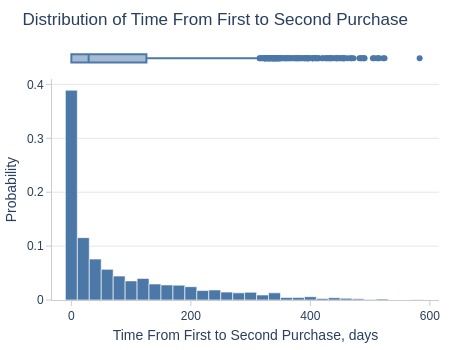
Key Observations:
~50% have >29 days between 1st/2nd purchase
Top 25% have ≥125 days
Top 5% have ≥319 days
Time from First to Last Purchase#
Let’s identify the top customers.
customer_top('from_first_to_last_days')
| from_first_to_last_days | orders_cnt | |
|---|---|---|
| customer_unique_id | ||
| d8f3c4f441a9b59a29f977df16724f38 | 582.86 | 2 |
| 8f6ce2295bdbec03cd50e34b4bd7ba0a | 537.39 | 3 |
| a1c61f8566347ec44ea37d22854634a1 | 524.10 | 2 |
| a262442e3ab89611b44877c7aaf77468 | 521.93 | 2 |
| 18bc87094128bbfe943cf88adcf72059 | 514.51 | 2 |
| 7e7301841ddb4064c2f3a31e4c154932 | 514.28 | 2 |
| 1b6e96ed99cb8d135efe220d761bbd67 | 511.49 | 3 |
| 24072811917876a84c81166f96aed0c1 | 510.90 | 2 |
| 408aee96c75632a92e5079eee61da399 | 506.27 | 2 |
| 97258e1c1f77f32358eccd1c9ee5954d | 504.65 | 2 |
Key Observations:
User ‘d8f3c4f441a9b59a29f977df16724f38’ has longest 1st→last purchase span (2 purchases)
Let’s see at statistics and distribution of the metric.
df_customers['from_first_to_last_days'].explore.info(
labels=dict(from_first_to_last_days='Time From First to Last Purchase, days')
, title='Distribution of Time From First to Last Purchase'
)
| Summary | Percentiles | Detailed Stats | Value Counts | |||||||
|---|---|---|---|---|---|---|---|---|---|---|
| Total | 2.79k (3%) | Max | 582.86 | Mean | 87.25 | 0.00 | 281 (<1%) | |||
| Missing | 92.98k (97%) | 99% | 448.81 | Trimmed Mean (10%) | 65.23 | 0 | 236 (<1%) | |||
| Distinct | 2.15k (2%) | 95% | 334.65 | Mode | 0.00 | 0.00 | 77 (<1%) | |||
| Non-Duplicate | 2.13k (2%) | 75% | 140.11 | Range | 582.86 | 0.00 | 21 (<1%) | |||
| Duplicates | 93.62k (98%) | 50% | 34.83 | IQR | 140.10 | 0.00 | 10 (<1%) | |||
| Dup. Values | 18 (<1%) | 25% | 0.01 | Std | 113.39 | 0.00 | 6 (<1%) | |||
| Zeros | 236 (<1%) | 5% | 0 | MAD | 51.63 | 0.00 | 6 (<1%) | |||
| Negative | --- | 1% | 0 | Kurt | 1.58 | 0.00 | 4 (<1%) | |||
| Memory Usage | 1 | Min | 0 | Skew | 1.49 | 0.00 | 3 (<1%) | |||
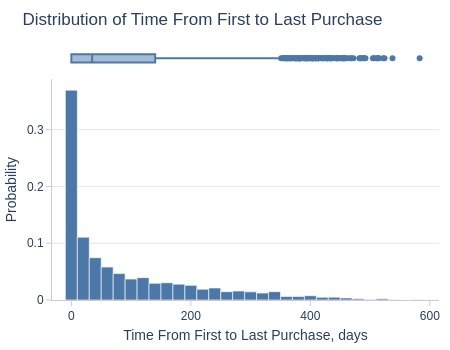
Key Observations:
~50% have >35 days between 1st/2nd purchase
Top 25% have ≥140 days
Top 5% have ≥335 days
Number of Months with Purchases#
Let’s identify the top customers.
customer_top('months_with_buys')
| months_with_buys | orders_cnt | |
|---|---|---|
| customer_unique_id | ||
| 8d50f5eadf50201ccdcedfb9e2ac8455 | 9.00 | 17 |
| ca77025e7201e3b30c44b472ff346268 | 6.00 | 7 |
| f0e310a6839dce9de1638e0fe5ab282a | 6.00 | 6 |
| 6469f99c1f9dfae7733b25662e7f1782 | 6.00 | 7 |
| 63cfc61cee11cbe306bff5857d00bfe4 | 5.00 | 6 |
| 7305430719d715992b00be82af4a6aa8 | 4.00 | 4 |
| dc813062e0fc23409cd255f7f53c7074 | 4.00 | 6 |
| a1874c5550d2f0bc14cc122164603713 | 4.00 | 4 |
| 5e8f38a9a1c023f3db718edcf926a2db | 4.00 | 5 |
| 738ffcf1017b584e9d2684b36e07469c | 4.00 | 4 |
Key Observations:
User ‘8d50f5eadf50201ccdcedfb9e2ac8455’ had most months with purchases
Let’s see at statistics and distribution of the metric.
df_customers['months_with_buys'].explore.info(
labels=dict(months_with_buys='Number of Months with Purchases')
, title='Distribution of Number of Months with Purchases per Customer'
, nbins=10
)
| Summary | Percentiles | Detailed Stats | Value Counts | |||||||
|---|---|---|---|---|---|---|---|---|---|---|
| Total | 93.23k (97%) | Max | 9 | Mean | 1.02 | 1 | 91.55k (96%) | |||
| Missing | 2.54k (3%) | 99% | 2 | Trimmed Mean (10%) | 1 | 2 | 1.58k (2%) | |||
| Distinct | 7 (<1%) | 95% | 1 | Mode | 1 | 3 | 87 (<1%) | |||
| Non-Duplicate | 2 (<1%) | 75% | 1 | Range | 8 | 4 | 17 (<1%) | |||
| Duplicates | 95.77k (99%) | 50% | 1 | IQR | 0 | 6 | 3 (<1%) | |||
| Dup. Values | 5 (<1%) | 25% | 1 | Std | 0.15 | 5 | 1 (<1%) | |||
| Zeros | --- | 5% | 1 | MAD | 0 | 9 | 1 (<1%) | |||
| Negative | --- | 1% | 1 | Kurt | 195.89 | |||||
| Memory Usage | 1 | Min | 1 | Skew | 10.54 | |||||
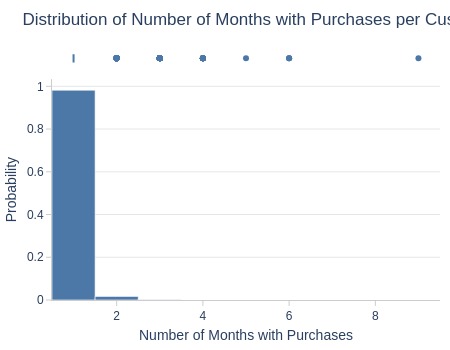
Key Observations:
96% of customers only purchased in 1 month
Maximum Consecutive Months with Purchases#
Let’s identify the top customers.
customer_top('max_consecutive_months_with_buys')
| max_consecutive_months_with_buys | orders_cnt | |
|---|---|---|
| customer_unique_id | ||
| 8d50f5eadf50201ccdcedfb9e2ac8455 | 6.00 | 17 |
| 6469f99c1f9dfae7733b25662e7f1782 | 5.00 | 7 |
| 1b6c7548a2a1f9037c1fd3ddfed95f33 | 4.00 | 7 |
| 3e43e6105506432c953e165fb2acf44c | 3.00 | 9 |
| e0836a97eaae86ac4adc26fbb334a527 | 3.00 | 3 |
| e0c99ffdcd8891130985ac90cd2d8eec | 3.00 | 3 |
| f0e310a6839dce9de1638e0fe5ab282a | 3.00 | 6 |
| 935b9c5a3162185f88dac06d8d08d623 | 3.00 | 3 |
| 2ddc001b620bd90d0f4378cfde1db887 | 3.00 | 4 |
| ca77025e7201e3b30c44b472ff346268 | 3.00 | 7 |
Let’s see at statistics and distribution of the metric.
df_customers['max_consecutive_months_with_buys'].explore.info(
labels=dict(max_consecutive_months_with_buys='Maximum Consecutive Months with Purchases')
, title='Distribution of Maximum Consecutive Months with Purchases'
, nbins=10
)
| Summary | Percentiles | Detailed Stats | Value Counts | |||||||
|---|---|---|---|---|---|---|---|---|---|---|
| Total | 93.23k (97%) | Max | 6 | Mean | 1.00 | 1 | 92.79k (97%) | |||
| Missing | 2.54k (3%) | 99% | 1 | Trimmed Mean (10%) | 1 | 2 | 438 (<1%) | |||
| Distinct | 6 (<1%) | 95% | 1 | Mode | 1 | 3 | 8 (<1%) | |||
| Non-Duplicate | 3 (<1%) | 75% | 1 | Range | 5 | 4 | 1 (<1%) | |||
| Duplicates | 95.77k (99%) | 50% | 1 | IQR | 0 | 6 | 1 (<1%) | |||
| Dup. Values | 3 (<1%) | 25% | 1 | Std | 0.07 | 5 | 1 (<1%) | |||
| Zeros | --- | 5% | 1 | MAD | 0 | |||||
| Negative | --- | 1% | 1 | Kurt | 523.67 | |||||
| Memory Usage | 1 | Min | 1 | Skew | 18.41 | |||||
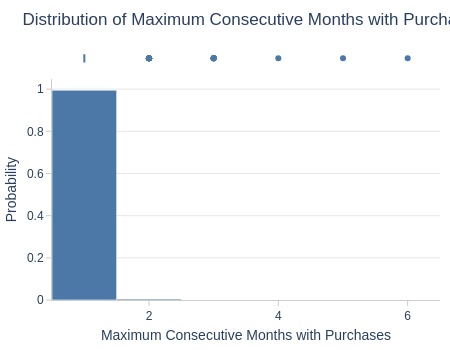
Key Observations:
Maximum consecutive months: 6 (1 customer)
3 consecutive months: 8 customers
2 consecutive months: 438 customers
Additional Metrics#
What percentage of customers make only one purchase?
tmp_df_res = df_sales.groupby(['customer_unique_id'])['order_id'].nunique()
display(f'{(tmp_df_res[tmp_df_res == 1].count() * 100 / tmp_df_res.count()).round(2)}% of customers make a purchase only once')
'97.01% of customers make a purchase only once'
What percentage of customers make more than one purchase?
display(f'{(tmp_df_res[tmp_df_res > 1].count() * 100 / tmp_df_res.count()).round(2)}% of customers make more than one purchase')
'2.99% of customers make more than one purchase'
What percentage of customers make more than two purchases?
display(f'{(tmp_df_res[tmp_df_res > 2].count() * 100 / tmp_df_res.count()).round(2)}% of customers make more than two purchases')
'0.24% of customers make more than two purchases'
What percentage of customers make more than three purchases?
display(f'{(tmp_df_res[tmp_df_res > 3].count() * 100 / tmp_df_res.count()).round(2)}% of customers make more than two purchases')
'0.05% of customers make more than two purchases'
What percentage of customers make 4 or more purchases?
for n in range(4, 10):
display(f'{(tmp_df_res[tmp_df_res > n].count() * 100 / tmp_df_res.count()).round(2)}% of customers make more than {n} two purchases')
'0.02% of customers make more than 4 two purchases'
'0.01% of customers make more than 5 two purchases'
'0.01% of customers make more than 6 two purchases'
'0.0% of customers make more than 7 two purchases'
'0.0% of customers make more than 8 two purchases'
'0.0% of customers make more than 9 two purchases'
Are there customers who make purchases regularly (monthly)?
tmp_df_res = df_sales[['order_purchase_dt', 'customer_unique_id', 'order_id']].dropna(subset='order_purchase_dt')
tmp_df_res['year_month'] = tmp_df_res.order_purchase_dt.dt.to_period('M')
tmp_df_res['first_month'] = tmp_df_res.groupby('customer_unique_id')['year_month'].transform('min')
last_month = tmp_df_res['year_month'].max()
tmp_df_res = (tmp_df_res.groupby('customer_unique_id', as_index=False)
.agg(
year_months = ('year_month', 'nunique')
, first_month = ('first_month', 'first')
)
)
tmp_df_res['all_months'] = (last_month - tmp_df_res.first_month).apply(lambda x: x.n + 1)
tmp_df_res['is_in_all_months'] = tmp_df_res['all_months'] == tmp_df_res['year_months']
tmp_df_res = tmp_df_res[tmp_df_res.is_in_all_months]
tmp_df_res.sort_values('all_months', ascending=False).head(10)
| customer_unique_id | year_months | first_month | all_months | is_in_all_months | |
|---|---|---|---|---|---|
| 81877 | e0836a97eaae86ac4adc26fbb334a527 | 3 | 2018-06 | 3 | True |
| 23908 | 4186b96df8197e7b4982a751c1dde3b6 | 2 | 2018-07 | 2 | True |
| 9611 | 1a2ede4e787ad199c46719ecb02d81ea | 2 | 2018-07 | 2 | True |
| 75435 | cef42836ff25476d55c9a3e58f8da99d | 2 | 2018-07 | 2 | True |
| 5194 | 0e381ce773b382849206115413009851 | 2 | 2018-07 | 2 | True |
| 31177 | 5568fb2b583235812ed08eb9587d0465 | 2 | 2018-07 | 2 | True |
| 42598 | 74b8021516f25eb91f5b4e704a2cd671 | 2 | 2018-07 | 2 | True |
| 33646 | 5c00e849b56a56ea31560d5d66f933e9 | 2 | 2018-07 | 2 | True |
| 77501 | d44f553a3663a6323c901cf1f0a47c87 | 2 | 2018-07 | 2 | True |
| 45360 | 7c588c097689b0b77fd73d171332b0ba | 2 | 2018-07 | 2 | True |
Key Observations:
No customers purchased in all months
Maximum regular purchases: 2 consecutive months
